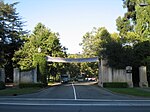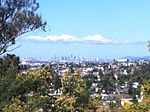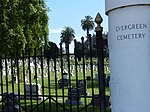Mills College
Mills College is a private women's liberal arts college in Oakland, California. Mills is an undergraduate women's college for women and gender non-binary students with graduate programs for students of all genders. Mills was founded as the Young Ladies Seminary in 1852 in Benicia, California; it was relocated to Oakland in 1871, and became the first women's college west of the Rockies. In 2014, Mills became the first single-sex college in the U.S. to adopt an admission policy explicitly welcoming transgender students.Mills College offers more than 45 undergraduate majors and minors and over 30 graduate degrees, certificates, and credentials. It is home to the Mills College School of Education and the Lorry I. Lokey School of Business & Public Policy. In March 2021, citing financial concerns that were augmented by the pandemic, President Elizabeth L. Hillman announced that Mills College would begin transitioning away from being a degree-granting college in the fall of 2021, instead becoming Mills Institute. The announcement was made to the Mills College alumnae in a letter posted online.In June 2021, following interest in merging with UC Berkeley by some Mills College alumnae, the college instead announced that it intended to merge with Northeastern University (a once all-male college that admitted its first female students in 1943) to become Mills College at Northeastern University.Despite a campaign by Mills College alumnae to stop the controversial merger with Northeastern University and a temporary stay imposed by a judge, the merger was confirmed by the Mills College Board of Trustees on September 14, 2021. President Hillman's role in the new Institution has not yet been announced. Mills College alumnae, who have donated a considerable portion of the college's endowment, continue to pursue legal options for halting the merger with Northeastern while they fight for financial transparency and a financial rationale for the immediacy of the merger, given the college's billions of dollars in assets, including Bay Area real estate, rare books, and a valuable art collection that is housed by the Mills College Art Museum. Uncertainty remains regarding institutional control of Mills College's considerable financial assets. No financial details regarding the impending merger have been made public to date.
Excerpt from the Wikipedia article Mills College (License: CC BY-SA 3.0, Authors).Mills College
Orchard Meadow Road, Oakland
Geographical coordinates (GPS) Address External links Nearby Places Show on map
Geographical coordinates (GPS)
| Latitude | Longitude |
|---|---|
| N 37.780555555556 ° | E -122.18305555556 ° |
Address
Mills College
Orchard Meadow Road
94619 Oakland
California, United States
Open on Google Maps




